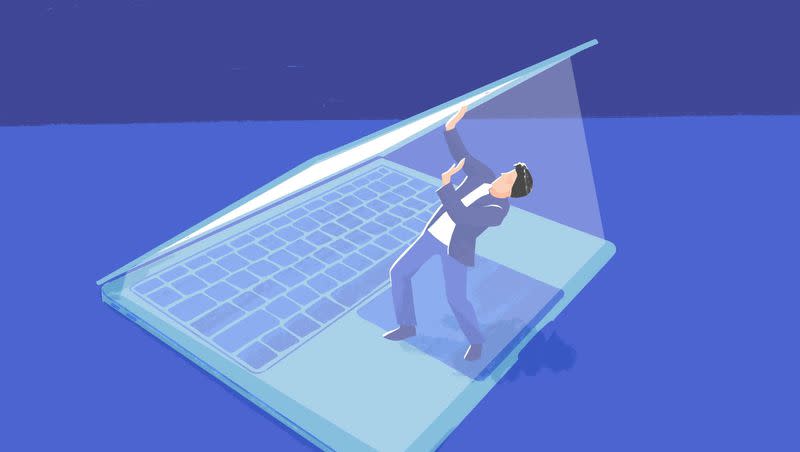The narrative is Utah leads the nation in pornography consumption. Data tell a different story

The website Pornhub is protesting one of Utah’s new laws — SB287, which requires pornographic websites to verify the ages of their users before they can access content. In retaliation, Pornhub announced this week it had blocked access entirely to Utah users.
Louisiana as well as countries such as Germany and the United Kingdom have sought to enforce similar age verification requirements to prevent minors from seeing “harmful material.” But news of Pornhub’s recent retaliation against Utah — and an increase in Utahns now looking for ways to circumvent Pornhub’s digital blockade — has once again surfaced the incorrect narrative that Utah leads the nation in per capita porn consumption.
It I remember reading that Utah had the highest per capita porn viewing?
— Nicholas A. Christakis (@NAChristakis) May 2, 2023
While publications in the past have reported Utah as having the highest rate of pornography usage in the country, this narrative appears to be based on a single nearly 15-year-old study about “subscriptions” to a website that still remains anonymous.
Related
For example, Pornhub’s own statistics from 2013 showed Utah ranked 40th in the U.S. in terms of page views. An article in Cyberpsychology said when controlled for broadband internet access, Utah ranks last based on Pornhub’s data.
As noted, the narrative of Utah residents consuming the most pornography emerged from the research report produced by then-Harvard Business professor Benjamin Edelman using data from 2008 or earlier. Edelman looked at zip codes from credit cards which an anonymous adult entertainment site gave him access to and said Utah had the most subscriptions out of any state in the country.
When Edelman published the research, he told the Deseret News, “one possibility is that Utah consumers find it difficult to obtain their desired adult entertainment through retail purchases. … As a result, Utah residents may be buying online (hence appearing in my dataset), whereas people elsewhere buy retail (hence not in my dataset).”
Utah’s youngest-in-the-nation population may have also been a contributing factor, he said (younger people tend to consume more pornography). Utah also has a very low number of strip clubs per capita. In other words, access to explicit content in the state may have simply been more difficult in the state during the mid-to-late aughts driving subscriptions up.
Or the study may just be an outlier.
“When we zoom out from this single study, there are 23 other studies that tell the opposite story,” according to Jacob Hess in Public Square Magazine. “Religious people are substantially less likely to use pornography than non-religious folks.”
Data on Utah specifically as well as the relationship between religiosity and pornography indicate a lower consumption rate.
In a 2015 review from academic journal Cyberpsychology, researchers compared the results of other studies with Edelman’s, including a 2012 New Family Structures Survey, Google Trend data from 2013-2014 and 2013 data from Pornhub (both paid subscriptions and unpaid access).
Utah ranked 50th, 46th and 51st, respectively, in these other studies.
According to the authors of the review, Edelman acknowledged “it is difficult to confirm rigorously that this seller is representative.” Data from a single company doesn’t tell the whole story and when the data is taken together, it seems Utah residents have a lower pornography consumption rate than residents of other states.
Another issue the authors raised with using Edelman’s study to suggest Utah has a high pornography consumption rate is paid subscription data accounts for a rather limited view of pornography usage, since most online pornography is now accessed for free online. While Edelman’s study looked at subscriptions for one particular company, his study isn’t necessarily representative of Utah as a whole.
The narrative about Utah’s porn consumption is often used to portray religious conservatives as hypocritical about their sexual ethics. But there’s plenty of evidence that shows high religiosity lead to less pornography consumption.
Related
In a 2020 article, Samuel Perry and Andrew Whitehead, researchers publishing in the sociological journal Socius, drew from a survey of 15,738 U.S. adults and analyzed the data to determine if people in conservative states (which tend to have higher rates of religiosity) consumed more pornography, as Edelman’s study and others suggested. Perry and Whitehead wrote, “individual-level religiosity and political conservatism predict less recent pornography consumption.”
Even though Perry and Whitehead concluded some people who live in conservative states may consume more pornography, the individually religious and conservative people are less likely to be the ones doing so. In other words, there isn’t a positive correlation between individual religiosity along with conservatism and pornography consumption.
“The preponderance of studies reports far lower rates of porn use in religious individuals compared with non-religious individuals,” Hess wrote. “In fact, comparisons between religious and non-religious rates are not even close.”
This doesn’t mean there aren’t religious people or people in the state of Utah who consume pornography. There certainly are. But relying on a single study to tell the whole story about Utah provides a distorted and tortured picture of the real thing.

